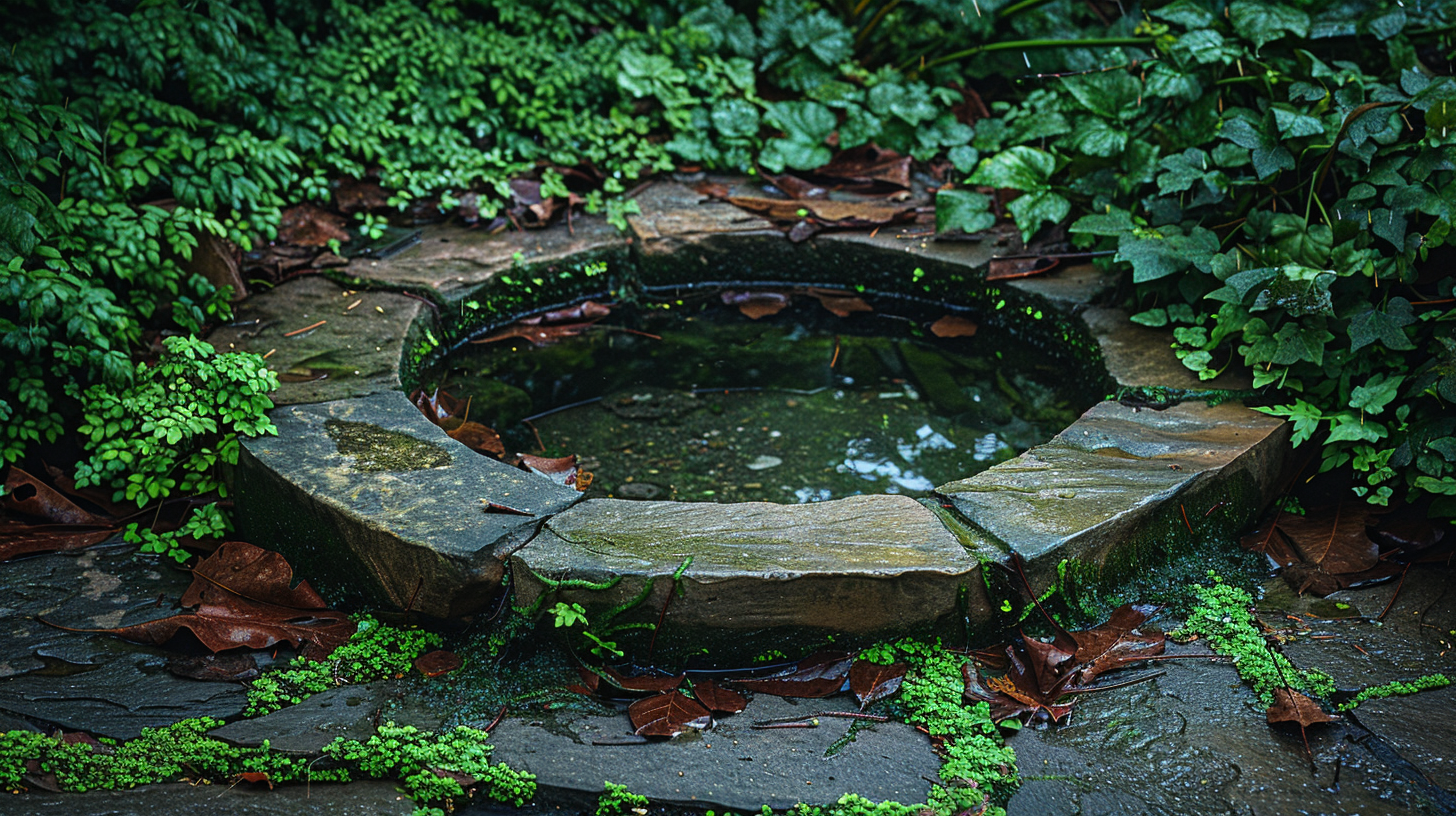Key points
• Landscaping: Add plants, blooms, or little bushes to cleverly hide the septic tank lid, making sure not to block the way for when it needs fixing. Pick plants with short roots so they won’t harm your septic system.
• Decorative Covers: Go for a fancy cover or a mock rock designed to blend in with the tank cover. Make sure it’s easy to take off when you need to get to the septic tank.
• Install a Riser: If your septic tank cover is underground, think about putting in a riser. This will raise the lid up to ground level, and then you can put something on top that doesn’t stick out too much but can still be taken off quickly.
Contents
- 1 Key points
- 2 Facing Up to Uncovered Septic Tank Lids
- 3 Different Septic Tank Covers
- 4 Regulations and Safety
- 5 Natural Concealment Methods
- 6 Artificial Hiding Tricks
- 7 Hiding Your Septic Tank Cover with Flair
- 8 Regular Checks and Easy Access
- 9 Seasonal Considerations for Plant Growth
- 10 Handling Safety Issues
- 11 How Some People Hide Their Septic Tanks
- 12 Guide to Plant Root Lengths
- 13 Frequently Asked Questions (FAQ)
Facing Up to Uncovered Septic Tank Lids

While they’re needed, uncovered septic tank lids can cause a bunch of problems. They can be an ugly blemish in your yard and might even be dangerous if they’re not locked down tight or if someone trips over them.
How They Look
Septic tank lids can stick out like a sore thumb in your garden’s look. Lots of folks work hard to make their yards look perfect and a septic lid that sticks up can throw a wrench in those plans, pushing people to come up with clever ways to hide it.
Taking Precaution
On top of looking bad, open septic tank covers could be a real safety threat, They need to be made safe so they don’t cause any mishaps or injuries, especially since it’s easy to miss them and trip.
Different Septic Tank Covers
Septic tank covers come in three main types: concrete, plastic, and metal. Each kind has its own good points.
Concrete Covers: These guys are tough and heavy, which means they last a long time and can handle rough weather. They don’t break down easily.
Plastic Covers: Not as heavy as concrete, plastic covers are simple to move around. They’re also good at keeping water out and don’t rust, which is a plus if you’re in a place that gets a lot of rain.
Metal Covers: Usually made from hard stuff like cast iron or steel, these covers are solid but watch out for rust. You’ll probably have to take care of them more often to keep them working right and in good shape.
Regulations and Safety

Importance of Easy Access for Maintenance
Checking and maintaining your septic system regularly is vital. Having covers that are easy to get to makes tasks like pumping and inspection simpler. Overlooking the need for easy access might cause headaches and high expenses down the line.
To wrap it up, when you’re hiding septic tank covers, remember looks are important but don’t forget about following safety rules and laws. You can use concrete, plastic, or metal covers, just make them safe and easy to work with when it’s time for maintenance.
Choosing the right way to hide a septic tank cover takes careful planning. Start by looking at your space to come up with a good hiding strategy. This first step ensures your choice not only masks the cover but also improves how your property looks. When planning, think about beauty and usefulness.
Assessing Your Space
Checking out the area around the septic cover is key. Knowing the size and shape of your yard helps you figure out the best way to hide the cover without it sticking out. Each yard is different—understand yours to pick the right camouflage that fits right in with its look.
Identifying the Location of the Septic Tank
Finding where your septic tank and covers are is super important. Once you know exactly where it is, choosing how to cover it up gets easier. Make sure you pinpoint this spot to dodge problems with access later on.
Understanding Soil and Drainage Patterns
Keep in mind how your soil works and how water moves through it around your septic system. These things matter not just for your tank’s health, but also for picking how to hide it. Some plants or decorations might not be great for your soil or could mess with drainage.
Design Considerations
When it comes to design plans, think about what’s practical but also looks good. Look around your garden and see how you can blend hiding spots for your tank into what’s already there. Pick materials and designs that cover the tank and add beauty to your yard.
Matching Landscape Aesthetics
Your disguise should feel like it’s part of the yard. Plants, rocks, or fake decorations like statues should match and add to your outdoor vibe. Go for something that fits well with the rest of your backyard design.
Long-term Access and Maintenance
Last thing: whatever you choose to conceal your tank has to consider future maintenance needs. Don’t block access; place covers smartly. It’s important that when it’s time for routine checks or quick fixes, getting to the tank isn’t a pain or wrecks your yard style.
Natural Concealment Methods
If you want to hide your septic tank cover in a subtle way, using nature is usually the best starting point. This can be done by choosing the right plants or adding natural elements like stones and big rocks into your yard. The aim is to blend the septic cover into the garden without messing up how the system works.
Planting Strategies
To cover up septic tank lids, good planting ideas are key. But it’s important to pick plants that won’t mess with your septic system. Choose plants with roots that don’t grow long enough to damage the area, so your system stays safe while still being hidden.
Suitable Plant Species
Some of the best plants for hiding septic tank covers are perennials, small bushes, and decorative grasses. These types don’t have the risky, deep roots that could cause problems, they provide good coverage too.
Root System Considerations
When using plants as a cover, focus on their root structure. Go for those with shallow roots to avoid any harm to your septic tank. Also, make sure there’s enough room around the cover for when you need to get to it.
Using Rocks and Boulders
Besides plants, you can place rocks and boulders on purpose to keep the septic cover out of sight. This trick not only hides what you need it to but also makes your garden look more rugged and interesting.
Artificial Hiding Tricks
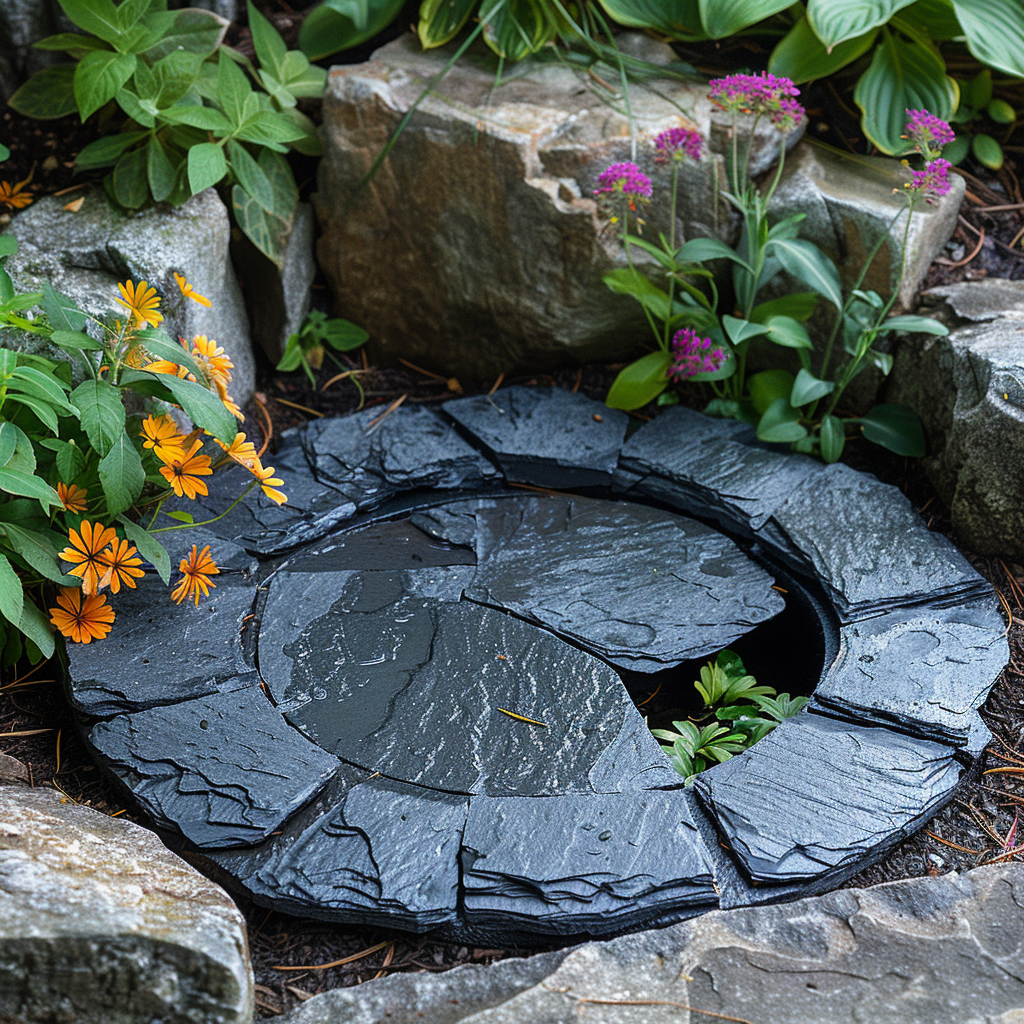
You’ve got a bunch of smart tricks for keeping your septic tank lid out of the limelight. These include decorative disguises and fake stones that look good and still make it simple to get in there when you need to fix stuff up.
Fancy Septic Tank Covers
You can find all sorts of made-to-order septic covers that look like real rocks or mulch. Pick one that goes well with your yard, and no one’s the wiser.
Pretend Rocks and Yard Stuff
Make-believe rock casings help hide septic lids while still looking nice and tidy. Match them with the actual rocks in your garden for a slick, put-together vibe.
Mixing It Up with Yard Decor
To sneakily cover your septic lid, you could tuck it among plant pots or mix it up with a bunch of real and fake stones. That way, it sort of just blends in and people don’t notice it as much.
Yard Sculptures and Decorations
Yard art and carvings are great for catching peoples’ eyes so they don’t spot your septic lid. Stick ’em close by, and folks will look at the shiny stuff instead of the boring bits.
Handy Stuff (like Bird Baths, Benches)
Adding things that are pretty and practical – think bird baths or benches – is clever ’cause they cover up your septic lid and make your garden nicer to hang out in.
When you’re using these hide-and-seek strategies for your septic, keep it chill and easy. Check back every now and then to make sure everything’s still working fine and not messing with your septic setup. Oh, and make sure the cute stuff isn’t getting in the way of the useful stuff.
Hiding Your Septic Tank Cover with Flair
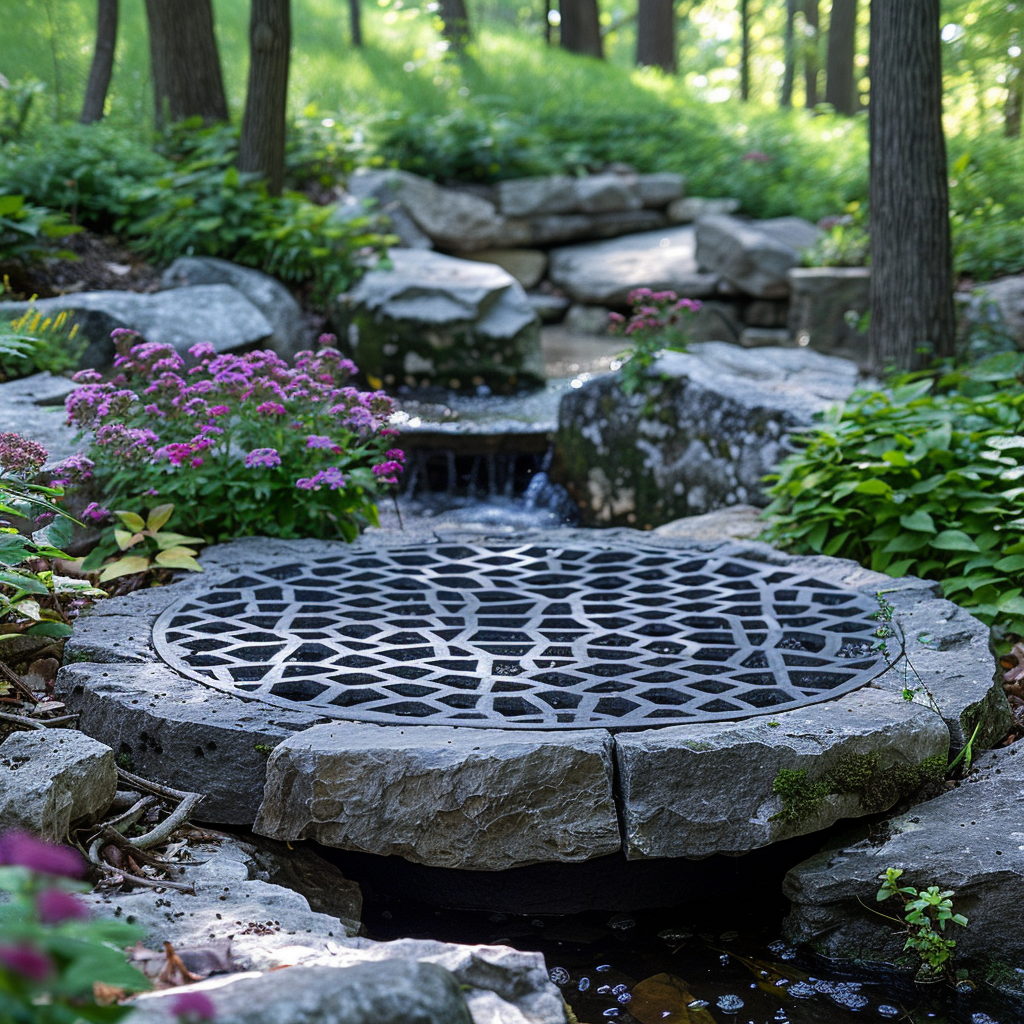
Don’t overcomplicate hiding your septic tank cover; a stylish approach is more straightforward than you might think. A removable garden box is a smart and attractive solution. First, measure the area around your septic lid to confirm your box can cover it properly.
Then, build a basic wooden frame that sits on top of the cover. Put some landscape fabric at the bottom of the frame for water drainage without losing soil. Choose plants or flowers that don’t need much room for their roots, so they won’t mess with the septic system underground. Ensure the garden box can be moved easily for when you need to reach the tank.
Creating a Stone Garden
Favoring a natural look? Consider making a stone garden. It’s appealing and doesn’t take much work to maintain. Start by getting various stones and small plants that do well in rocky environments. Place these strategically around the septic lid but make sure you can still get to the lid easily for checks or fixes. Mix up big stones with small ones and add some plants for a lovely touch. Just remember not to change the ground level above the tank too much to avoid damaging it.
Adding a Decorative Pathway
Laying down an eye-catching path near your septic cover enhances your yard’s beauty and steers attention away from the functional aspect. Use flagstones, pavers, or even mulch to make your pathway fit well with the rest of your landscape. When installing it, arrange your materials carefully so everything fits together tightly or spreads out evenly, remembering to leave enough space around the septic cover for easy access. This way, you get a practical yet decorative feature that draws the eye along the pathway instead of to the septic cover.
In every home project, mix what looks good with what works well; easy access for maintenance, choosing plants and features that won’t cause damage, and keeping on top of safety guidelines for your septic system should always be your priority. Follow these steps, and you’ll end up with a yard that’s as functional as it is delightful.
Regular Checks and Easy Access
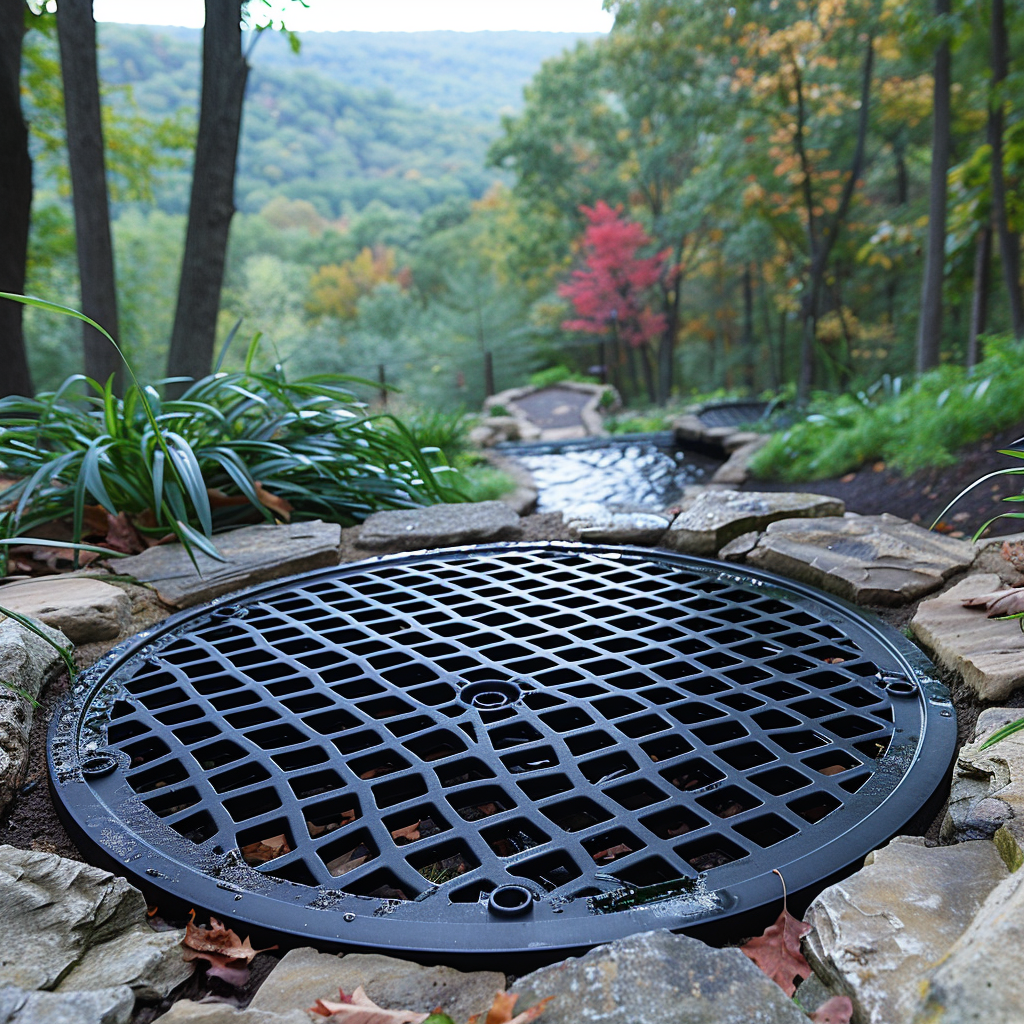
Looking after your septic system requires regular check-ups and keeping the path to your tank clear. It’s important for the lids to be handy for check-ups, and if you need to fix something, you can do it easily. You might want your septic tank lids to look nice with your yard, but don’t hide them completely or you’ll have trouble when it comes time for maintenance.
Your septic system must be cleaned out every few years to work right. Don’t let the lids get buried under stuff that makes them hard to find. A clear route to these spots means you can clean the tank fast, so you won’t have to deal with extra trouble or hold-ups.
Seasonal Considerations for Plant Growth
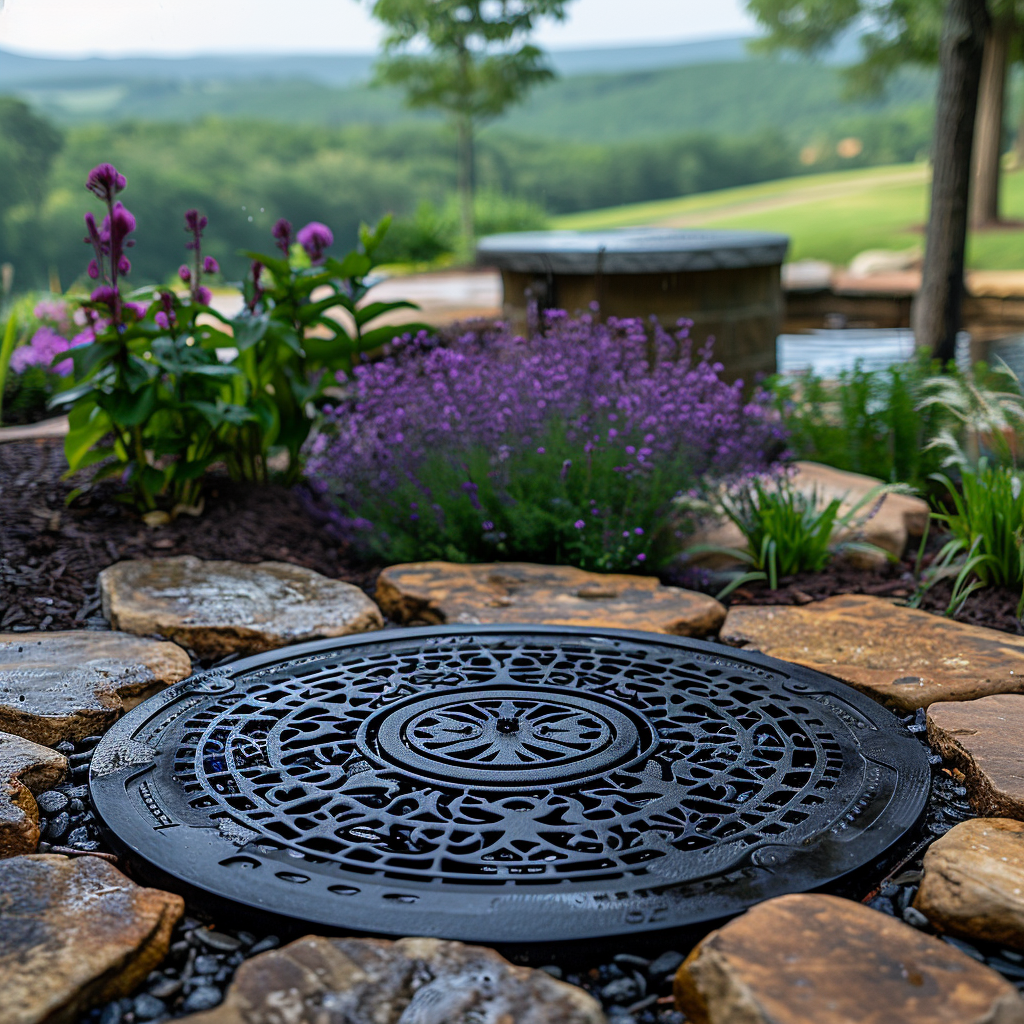
When you want to hide your septic tank and make it look better, it’s smart to choose plants that have shallow roots. These won’t mess with your septic setup. Also, pick plants that will stay pretty throughout the year. By doing this, you can have a nice-looking space all the time without causing problems for your septic system.
Handling Safety Issues
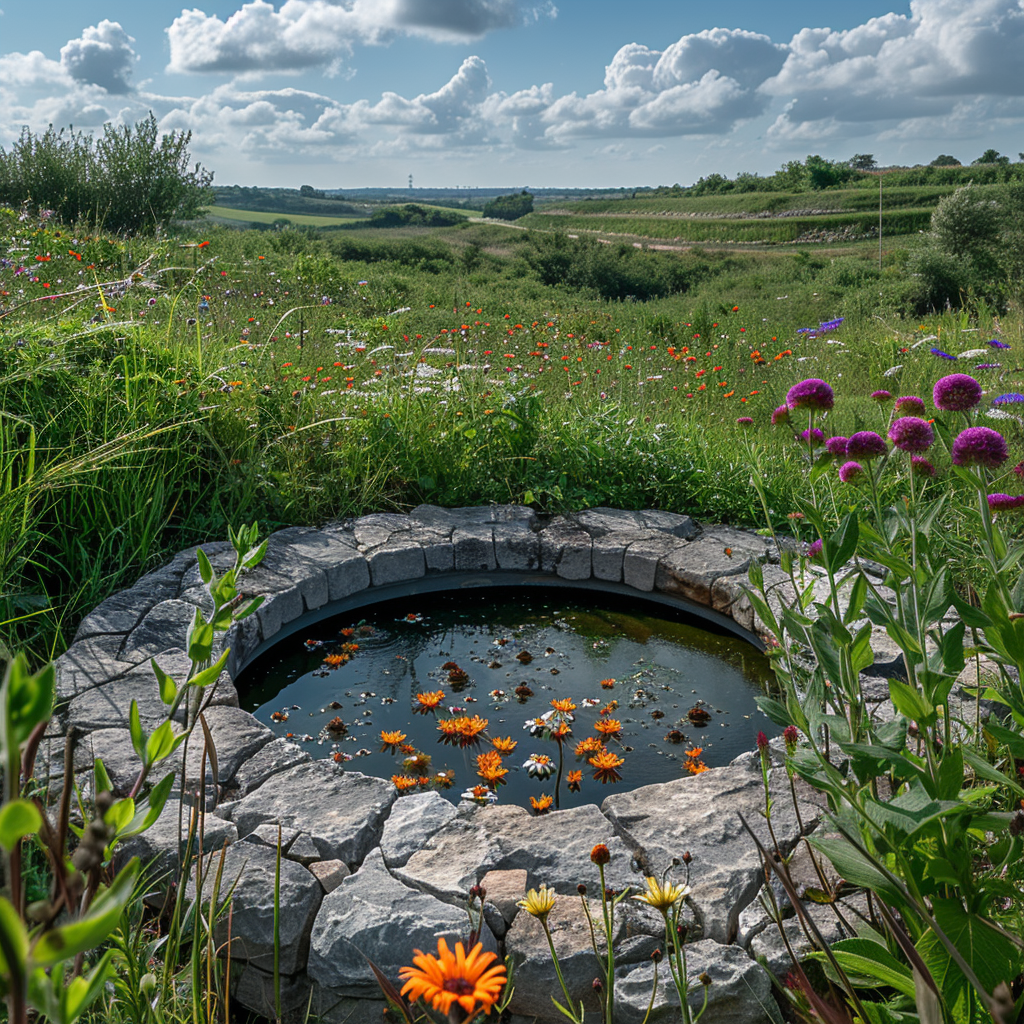
When you hide your septic covers, don’t forget to consider safety. If the lid isn’t level with the ground, someone could trip over it. Make sure the cover is even with the ground or clearly show where it’s higher to prevent accidents.
Avoiding Trips and Falls
The tank cover needs to be level with the lawn or a bit above it but with a warning sign. By doing this, you cut down on the chance that someone will trip and get injured. This way, your yard remains safe for everyone walking around.
Maintaining Good Air Flow
Your septic system must have good air flow to work right. Keep in mind not to block the air when you cover up your septic tank lid. So, any decorations should stay clear of the vents and exhausts that your septic setup needs.
How Some People Hide Their Septic Tanks
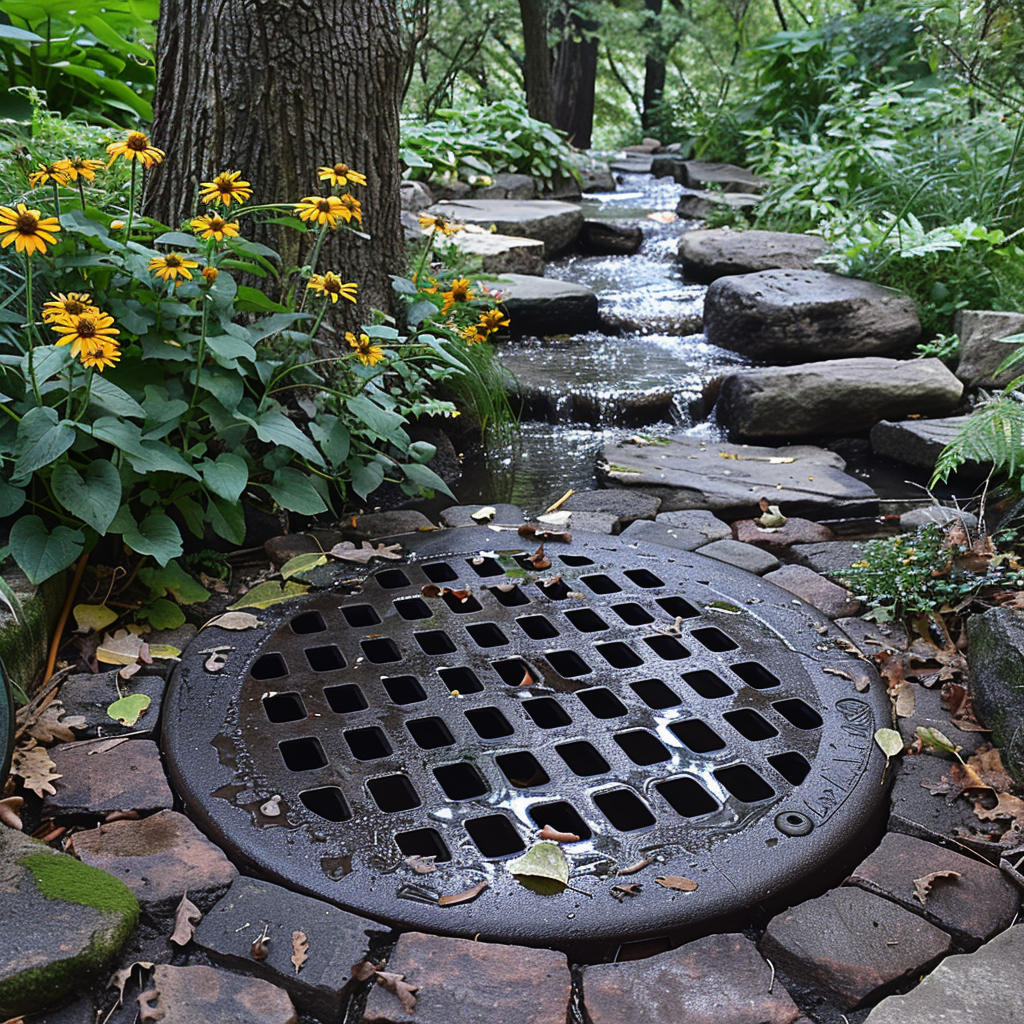
Nobody likes looking at septic tank covers in their beautiful yards. So, homeowners have come up with smart ways to hide them. By mixing a bit of clever gardening and some nice design touches, they’ve made these ugly but necessary parts of their yards look good. Here are some stories about people who’ve hidden their septic tanks really well.
Guide to Plant Root Lengths
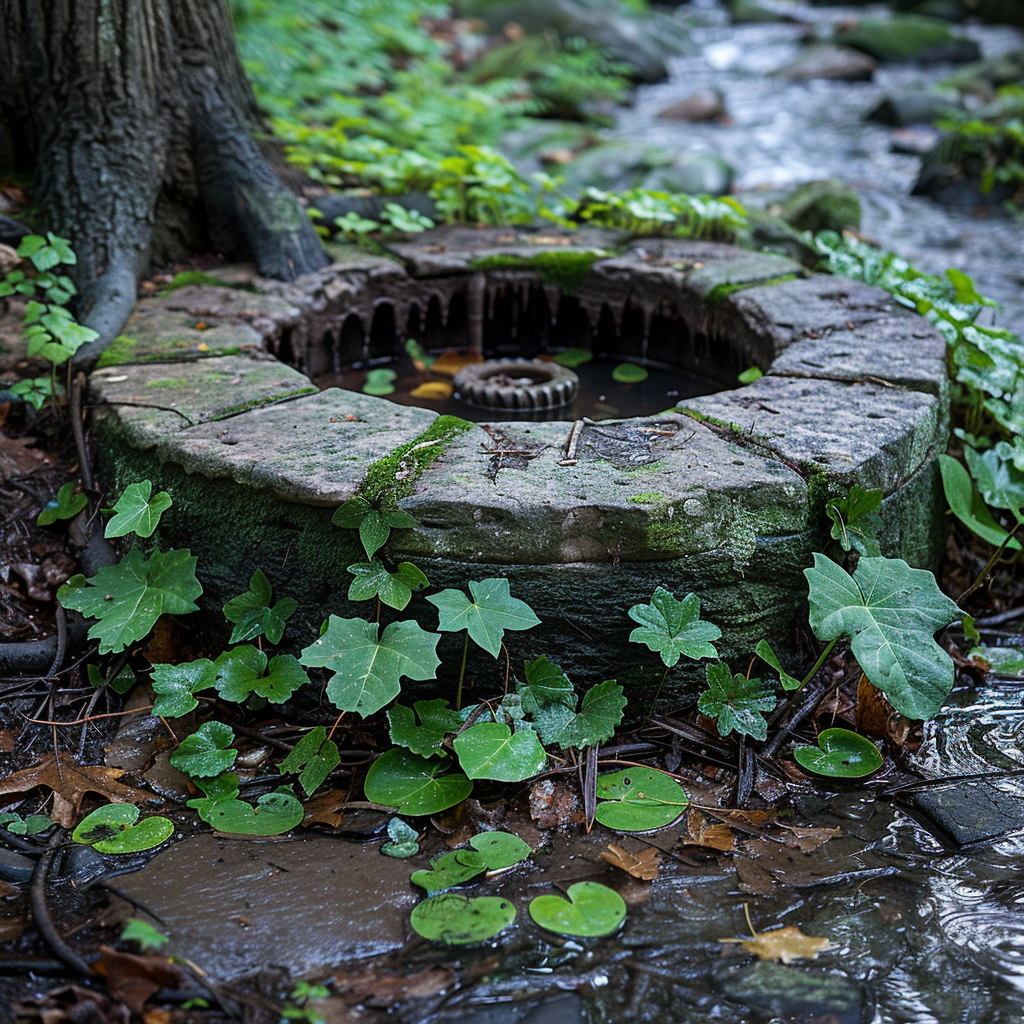
When you plant around a septic tank cover, it’s essential to consider how deep the roots go. You should choose plants with shallow roots because those with longer roots can mess up your underground septic system. Here are some plants that are grouped by how deep their roots grow:
Plants with Short Roots (Under 18 inches)
- Perennial flowers like daylilies (Hemerocallis species)
- Grasses used for lawns, such as Kentucky bluegrass (Poa pratensis)
- Some quick-living plants—petunias (Petunia × atkinsiana) are a fan favorite
Plants with Mid-Length Roots (18 – 36 inches)
- Lots of fancy grasses fit well into this group
- Harmless bushes like boxwood (Buxus species) are also good choices
Plants with Long Roots (Over 36 inches)
- Avoid big trees and shrubs; they’re just asking for trouble.
Frequently Asked Questions (FAQ)
Can landscaping additions near septic tank covers affect the septic systems' efficiency?
Yes, certain landscaping additions can lead to problems such as Tree root intrusion which might damage the pipes or tank. It’s crucial to choose the right type of plants and refrain from placing heavy decorations that can compact the soil over the drain field.
Are there any specific don’ts when it comes to disguises for septic tank lids in terms of preventing system damage?
Definitely. Avoid using deep-rooted trees or shrubs as they pose a risk for root intrusion. Heavy structures that put pressure on the septic tank or its pipes can also lead to costly damages and are a definite don’t.
In terms of aesthetics, what suggestions can you offer to homeowners looking to hide an eyesore septic lid?
For homeowners seeking to blend a septic lid with their lawn decoration, consider using light cover-ups like mulch or gravel, adding a decorative garden feature, or installing an aesthetically pleasing yet lightweight riser that complements the surrounding yard.
What's something budget-friendly that people living in West Bay & The Greater San Francisco Bay Area can do to cover their septic tank covers?
Residents of West Bay & The Greater San Francisco Bay Area looking to cover their septic tank covers without breaking the wallet can opt for simple DIY solutions like planting grass over lightweight polypropylene risers, or creating small flower beds with pavers surrounding the cover for both decoration and septic system camouflage.
Could corrosion be a reason why septic tank caps become more noticeable at ground level?
Corrosion can certainly lead to septic tank caps becoming prominent by causing them to shift or deteriorate. Make an Appointment with professionals to check for this issue and ensure your septic system is functioning well while maintaining curb appeal.
Is it possible for guests or neighbors not to mind the appearance of septic risers in my front lawn?
It is possible if you manage to effectively blend the risers with your landscape. Using decorations that match your home’s aesthetic or cleverly designed covers can make the risers less of an eyesore and may go unnoticed by anyone enjoying your outdoor space.

I’m Tim Robberts, a seasoned wastewater treatment & septic system expert with over 40 years of experience in the field. My career began as a septic tank installer, and I quickly gained a reputation for my attention to detail and commitment to excellence. Over the years, I’ve honed my skills in designing, installing, and maintaining septic systems for residential and commercial properties.
